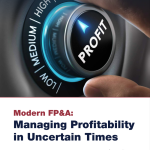In this article, the author explains how FP&A teams can impact pricing strategies for companies to...

Accurate financial forecasting is essential for businesses to maintain profitability and anticipate cash flows in today’s globalised, fast-paced economy. Customer returns are a key area that is often overlooked but still profoundly impacts financial forecasting.
Returns are influenced by a complex interplay of factors, including consumer behaviour, pricing strategies, payment methods, product and country mix, loyalty programs, global initiatives, environmental concerns, new product launches, and logistics. Since returns affect a wide range of operational and financial aspects, it is critical to examine the various drivers that contribute to this multi-line impact.
Consumer Behaviour
Consumer behaviour is the most direct driver of returns. Shifting preferences, such as the increased adoption of e-commerce, have resulted in a higher volume of returns. Online shoppers tend to return items more frequently than in-store shoppers, often due to sizing issues, quality mismatches or because they changed their minds. Forecasting returns accurately requires understanding these trends in consumer behaviour, especially during periods like holidays when returns spike. With minimal disincentives for returns and a vast product selection, a “why not try that one too” mentality is encouraged.
Moreover, the growing influence of social media can cause impulsive shopping, often resulting in product returns when trends change unexpectedly.
Pricing
Pricing strategies also play a pivotal role in influencing return rates. Lower-priced items often have higher return rates due to perceived lower risk by consumers when they make the purchase. Conversely, higher-priced goods, especially luxury items, tend to have lower return rates but result in greater financial impact when they occur. Promotions and discounts can also cause fluctuations in return volumes, especially if customers buy multiple items with the intention to keep only one. Incorporating price elasticity into financial models should be essential to predict how price fluctuations may influence returns.
Payment Methods
The payment method can also directly impact return behaviour. Payment methods such as Buy Now, Pay Later (BNPL) services encourage consumers to make impulsive purchases, which can potentially lead to higher return rates. On the other hand, customers who use credit cards or direct payments tend to make more calculated decisions, potentially lowering the likelihood of returns.
Country Mix
The geographical diversity of a company’s customer base may cause complexity in forecasting customer returns. Different regions have varying consumer habits and legal frameworks around returns. For example, some countries have more lenient return policies and may have customer behaviours that can increase return volumes. Furthermore, cultural attitudes toward consumption, product quality expectations and purchasing power contribute to the difference in return rates across countries.
Product Mix
A diverse product mix can significantly affect return rates. Apparel, electronics, and home goods tend to have higher return rates due to factors such as product dissatisfaction or wrong fit. For example, even within a specific industry, a particular product line, such as sandals, may have more returns associated with it than boots. Products also tend to carry additional costs when they are returned. Often, overseen factors, such as testing, refurbishing, or reshelving, can further affect financial forecasts.
It can be mitigated with genuine and accurate reviews and by finetuning the marketing information.
Loyalty Programs
Loyalty programs often aim to drive customer retention but can also lead to increased returns. Due to favourable policies and incentives, loyalty members, especially those at higher tiers, may feel more comfortable making returns. While this can enhance customer satisfaction, it also introduces variability in financial forecasting.
New Product Launches
New product launches are typically accompanied by heightened uncertainty around returns. Customers may return items more frequently due to unclear expectations or marketing misalignments. The analysis of past launches’ historical data supplemented by market research, especially for similar product categories, can help us predict return rates for new products.
Logistics
Returns not only affect the financial bottom line but also introduce significant logistical challenges. Companies must manage the reverse logistics chain, including the transportation of returned goods, assessing their condition, and determining whether they can be resold. Depending on their condition, returned products often need to be restocked, refurbished or even discarded.
Transporting returned goods back to warehouses or retail outlets introduces additional costs, such as fuel, labour and handling fees. Moreover, the time it takes to return items to the shelves for resale can affect inventory turnover rates and cash flow. Therefore, forecasting return-related logistics expenses is crucial for understanding the overall financial impact of returns.
Additionally, businesses should consider the potential of supply chain disruptions when forecasting returns. External events like pandemics, political unrest, or climate-related disasters can cause transportation delays and increase the cost of returns. Integrating these potential disruption factors into financial models allows companies to stay prepared for worst-case scenarios.
Corporate Social and Environmental Responsibility
Global initiatives, such as sustainability efforts, play a growing role in returns management. Many consumers are becoming more environmentally conscious and expect companies to have responsible return policies. These policies, such as offering eco-friendly return options or donations for unsellable products, can affect overall return volume and costs.
The environmental state is also influencing returns in terms of customer expectations and the company’s responsibility. Return logistics contribute to carbon emissions, and companies may face pressure to reduce returns or adopt sustainable practices in return logistics. This can introduce additional costs for businesses, such as using more eco-friendly packaging or optimising transport routes to reduce carbon footprints.
These initiatives should be integrated with financial forecasting models to assess the cost-benefit of different return policies. It may also include forecasting the potential impact of future product disposal or recycling regulations.
Role of FP&A
The FP&A function can be the architect of the solutions in multiple ways. For example, through the integration of cross-departmental information and data from marketing, sales, operations, and customer service, we can create comprehensive models. Furthermore, insights from marketing on product launches can help us predict spikes in returns, while logistics operational data can guide cost planning. Another way is to use advanced analytics tools like Machine Learning or Predictive Analytics to enhance forecast accuracy through the identification of patterns in return behaviour. This can help FP&A professionals generate more accurate forecasts that consider seasonality, market shifts and consumer sentiment.
For instance, we can also develop a returns mitigation strategy to reduce return rates. This strategy certainly can help reduce the volume of returns and their associated costs.
Conclusion
Customer returns are just an example of critical factors in financial forecasting, impacting revenue, operational costs, and profitability. By analysing the driving factors, ranging from consumer behaviour and price points to logistics and environmental initiatives, companies can create more accurate financial forecasts reflecting the true cost of returns. The complexities of global markets, product diversity, and shifting consumer preferences make this a challenging but necessary focus area for any forward-looking business. FP&A professionals can ensure that customer returns or any multi-dimensional items are not only accurately forecasted but also managed in a way that minimises financial risk and enhances operational efficiency, ultimately leading to improved profitability.
Subscribe to
FP&A Trends Digest

We will regularly update you on the latest trends and developments in FP&A. Take the opportunity to have articles written by finance thought leaders delivered directly to your inbox; watch compelling webinars; connect with like-minded professionals; and become a part of our global community.






